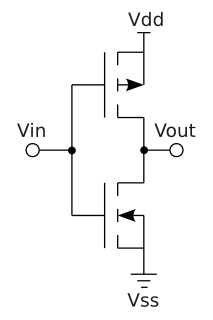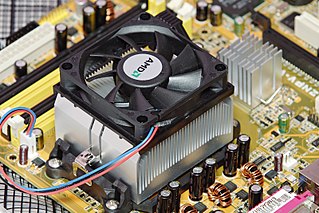
An integrated circuit or monolithic integrated circuit is a set of electronic circuits on one small flat piece of semiconductor material that is normally silicon. The integration of large numbers of tiny MOS transistors into a small chip results in circuits that are orders of magnitude smaller, faster, and less expensive than those constructed of discrete electronic components. The IC's mass production capability, reliability, and building-block approach to integrated circuit design has ensured the rapid adoption of standardized ICs in place of designs using discrete transistors. ICs are now used in virtually all electronic equipment and have revolutionized the world of electronics. Computers, mobile phones, and other digital home appliances are now inextricable parts of the structure of modern societies, made possible by the small size and low cost of ICs.

The StrongARM is a family of computer microprocessors developed by Digital Equipment Corporation and manufactured in the late 1990s which implemented the ARM v4 instruction set architecture. It was later sold to Intel in 1997, who continued to manufacture it before replacing it with the XScale in the early 2000s.

Complementary metal–oxide–semiconductor (CMOS), also known as complementary-symmetry metal–oxide–semiconductor (COS-MOS), is a type of metal–oxide–semiconductor field-effect transistor (MOSFET) fabrication process that uses complementary and symmetrical pairs of p-type and n-type MOSFETs for logic functions. CMOS technology is used for constructing integrated circuit (IC) chips, including microprocessors, microcontrollers, memory chips, and other digital logic circuits, and replaced earlier transistor-transistor logic (TTL) technology.

Computer cooling is required to remove the waste heat produced by computer components, to keep components within permissible operating temperature limits. Components that are susceptible to temporary malfunction or permanent failure if overheated include integrated circuits such as central processing units (CPUs), chipset, graphics cards, and hard disk drives.

Robert Drost is an American computer scientist. He was born in 1970 in New York City.

A network on a chip or network-on-chip is a network-based communications subsystem on an integrated circuit ("microchip"), most typically between modules in a system on a chip (SoC). The modules on the IC are typically semiconductor IP cores schematizing various functions of the computer system, and are designed to be modular in the sense of network science. The network on chip is a router-based packet switching network between SoC modules.

Rock was a multithreading, multicore, SPARC microprocessor under development at Sun Microsystems. Canceled in 2010, it was a separate project from the SPARC T-Series (CoolThreads/Niagara) family of processors.
Ambric, Inc. was a designer of computer processors that developed the Ambric architecture. Its Am2045 Massively Parallel Processor Array (MPPA) chips were primarily used in high-performance embedded systems such as medical imaging, video, and signal-processing.

Hot Chips is technological symposium held every year in August in Silicon Valley.
Hot Interconnects is an IEEE sponsored international symposium on High Performance Interconnects held every year starting 1993. The symposium intends to bring together the architects and designers of high performance interconnects, software and systems together on platform to discuss the latest trends in the area.
Low-power electronics are electronics, such as notebook processors, that have been designed to use less electric power than usual, often at some expense. In the case of notebook processors, this expense is processing power; notebook processors tend to consume less power than their desktop counterparts, at the expense of lower processing power.
FASTBUS is a computer bus standard, originally intended to replace Computer Automated Measurement and Control (CAMAC) in high-speed, large-scale data acquisition. It is also a modular crate electronics standard commonly used in data acquisition systems in particle detectors.

In computer engineering, computer architecture is a set of rules and methods that describe the functionality, organization, and implementation of computer systems. Some definitions of architecture define it as describing the capabilities and programming model of a computer but not a particular implementation. In other definitions computer architecture involves instruction set architecture design, microarchitecture design, logic design, and implementation.
The IEEE International Electron Devices Meeting (IEDM) is an annual micro- and nanoelectronics conference held each December that serves as a forum for reporting technological breakthroughs in the areas of semiconductor and related device technologies, design, manufacturing, physics, modeling and circuit-device interaction.
Heterogeneous computing refers to systems that use more than one kind of processor or cores. These systems gain performance or energy efficiency not just by adding the same type of processors, but by adding dissimilar coprocessors, usually incorporating specialized processing capabilities to handle particular tasks.
Gabriel Alfonso Rincón-Mora is a Venezuelan-American/Hispanic-American electrical engineer, scientist, professor, inventor, and author who was elected Fellow of the American National Academy of Inventors (NAI) in 2017, Fellow of the Institute of Electrical and Electronics Engineers (IEEE) in 2011, and Fellow of the Institution of Engineering and Technology (IET) in 2009 for contributions to energy-harvesting and power-supply integrated circuits (ICs). Texas Instruments awarded him a Three-Year Patent Award for U.S. 5,491,437, U.S. 5,500,625, and U.S. 5,519,341 in 1999; Hispanic Business Magazine voted him one of "The 100 Most Influential Hispanics" in 2000; the Society of Hispanic Professional Engineers (SHPE) awarded him the National Hispanic in Technology Award in 2000; Florida International University (FIU) awarded him the Charles E. Perry Visionary Award in 2000; the Georgia Institute of Technology inducted him into its Council of Outstanding Young Engineering Alumni in 2000; former Lieutenant Governor Cruz Bustamante of California presented him a State of California Commendation Certificate in 2001; Robins Air Force Base presented him the Orgullo Hispano Award in 2003 and the Hispanic Heritage Award in 2005; IEEE presented him the IEEE Service Award in 2007; and IEEE Circuits and Systems Society (CASS) named him IEEE Distinguished Lecturer in 2009-2010 and 2018-2019.
Energy proportionality is a measure of the relationship between power consumed in a computer system, and the rate at which useful work is done. If the overall power consumption is proportional to the computer's utilization, then the machine is said to be energy proportional. Equivalently stated, for an idealized energy proportional computer, the overall energy per operation is constant for all possible workloads and operating conditions. The concept was first proposed in 2007 by Google engineers Luiz André Barroso and Urs Hölzle, who urged computer architects to design servers that would be much more energy efficient for the datacenter setting. Energy proportional computing is currently an area of active research, and has been highlighted as an important design goal for cloud computing. There are many technical challenges remaining in the design of energy proportional computers. Furthermore, the concept of energy proportionality is not inherently restricted to computing. Although countless energy efficiency advances have been made in non-computing disciplines, they have not been evaluated rigorously in terms of their energy proportionality.

Eby G. Friedman is an electrical engineer, and Distinguished Professor of Electrical and Computer Engineering at the University of Rochester. Friedman is also a Visiting Professor at the Technion - Israel Institute of Technology. He is a Senior Fulbright Fellow and a Fellow of the IEEE.
The Institute of Electrical and Electronics Engineers sponsors more than 1,600 annual conferences and meetings worldwide. IEEE is also highly involved in the technical program development of numerous events including trade events, training workshops, job fairs, and other programs.

Timothy M. Pinkston is an American computer engineer, researcher, educator and administrator whose work is focused in the area of computer architecture. He holds the George Pfleger Chair in Electrical and Computer Engineering and is a Professor of Electrical and Computer Engineering at University of Southern California (USC). He also serves in an administrative role as Vice Dean for Faculty Affairs at the USC Viterbi School of Engineering.










